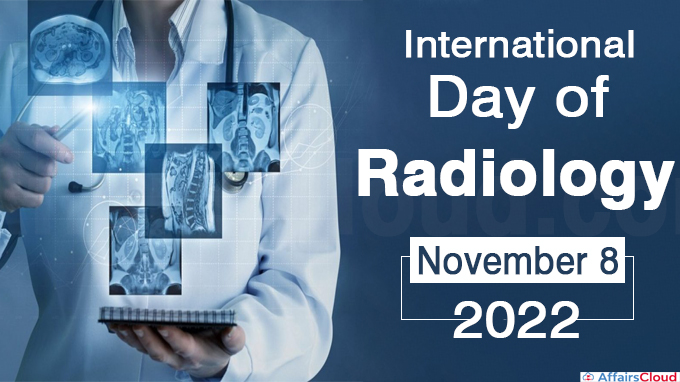 International Day of Radiology (IDoR), also known as World Radiology Day, is annually observed across the globe on November 8 to raise awareness of the benefits of medical imaging that incorporates radiology and to honour the discovery of X-rays by German engineer Wilhelm Conrad Röntgen Roentgen in 1895.
International Day of Radiology (IDoR), also known as World Radiology Day, is annually observed across the globe on November 8 to raise awareness of the benefits of medical imaging that incorporates radiology and to honour the discovery of X-rays by German engineer Wilhelm Conrad Röntgen Roentgen in 1895.
IDoR is observed to improve knowledge of how radiologists and radiological technologists contribute to healthcare.
- 8th November 2022 marks the observance of the 11th International Day of Radiology.
According to the European Society of Radiology (ESR), the theme of International Day of Radiology 2022 is “Radiologists & radiographers supporting patients”.
- According to the International Society of Radiographers and Radiological Technologists(ISRRT), the theme of World Radiography Day 2022 is “Radiographers at the Forefront of Patient Safety”.
Note: Wilhelm Conrad Röntgen received the 1st Nobel Prize in Physics in 1901 in recognition of the extraordinary services he rendered by the discovery of the remarkable rays (X-Rays).
Background:
i. Since 2007, 8th November, the day on which Wilhelm Conrad Röntgen discovered the x-rays, has been observed as World Radiography Day.
- In 2011, the European Society of Radiology (ESR) decided to have an annual radiology celebration on the anniversary of the discovery of x-rays.
ii. The date November 8 was chosen at the Radiological Society of North America (RSNA) meeting convened in Chicago by the Radiological Society of North America (RSNA), European Society of Radiology (ESR), and American College of Radiology (ACR).
iii. The first ever IDoR was observed on 8th November 2012.
Note: The ESR maintains a joint website to promote the International Day of Radiology
Radiology:
i. Radiology is the field of medicine that diagnoses and treats diseases using imaging techniques (X-rays). It began in Germany in 1895.
Note: Almost 268 medical schools across India run Radiology courses.
ii. Common diagnostic tools include X-rays, CT(Computed Tomography) scans, MRI(Magnetic Resonance Imaging) scans, and ultrasound scans.
Benefits of Radiology:
Rapid improvements in clinical radiography technology and theory have significantly improved sickness and injury diagnosis and treatment.
- It is used in illness screening, such as breast cancer (mammography), with early discovery lowering mortality rates.
- It improves cancer diagnosis and is also effective in cancer and other illness treatment (known as radiation oncology or radiation therapy).
Different Radiological Procedures have Different Advantages:
CT scan– It is a diagnostic imaging exam that produces images of the inside of the body using X-ray technology. It gives accurate, fast and painless results.
MRI scan– It creates three-dimensional images of soft tissues like organs and muscles that aren’t visible on X-rays.
- It can produce many (sometimes hundreds) of images stored on a computer or printed on film in 1 scan.
Nuclear medicine- It is to see how internal organs are functioning
PET (Positron Emission Tomography) scan– It is a nuclear medicine imaging test in which a small amount of liquid radioactive material is injected into the body. PET scans can detect cancer in the body earlier than CT or MRI scans.
- It can detect cancer in the body earlier than CT or MRI scans.
Ultrasound– It is an imaging method that uses sound waves to produce images of structures within your body. It is used in pregnancy to monitor the baby’s development.
About the Radiological Society of North America (RSNA):
President- Bruce G. Haffty, MD
Establishment- 1915
Members- more than 54,000 members across the globe
About the European Society of Radiology (ESR):
Chair of the ESR Board of Directors- Regina Beets-Tan
President- Adrian P. Brady
Establishment- 2005
Members- 129,294 members across the globe




